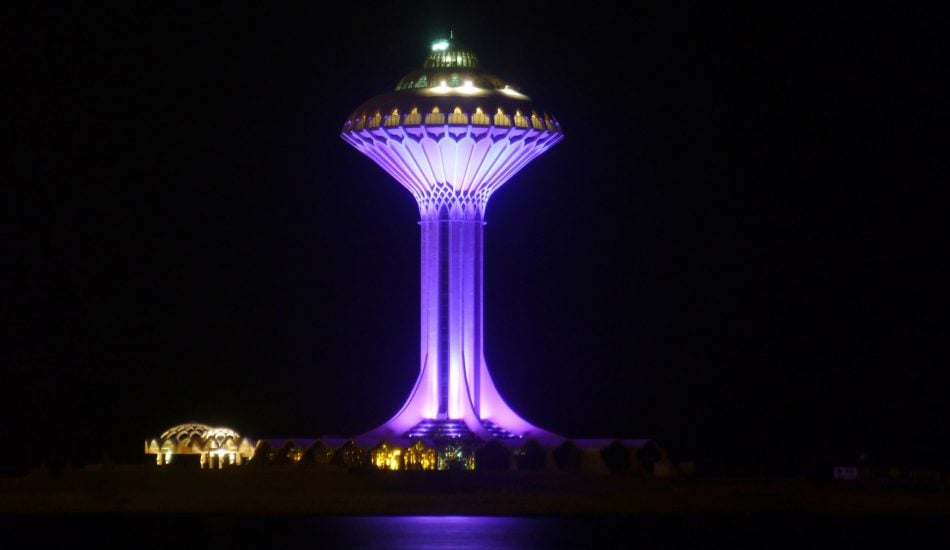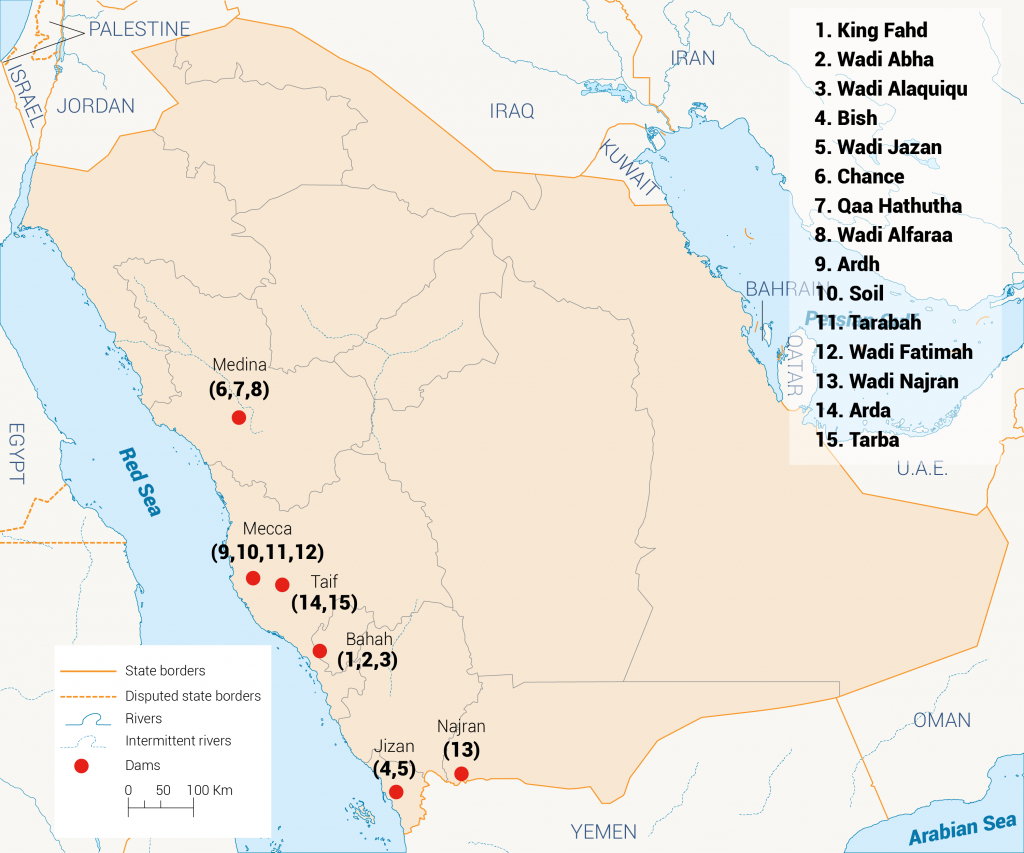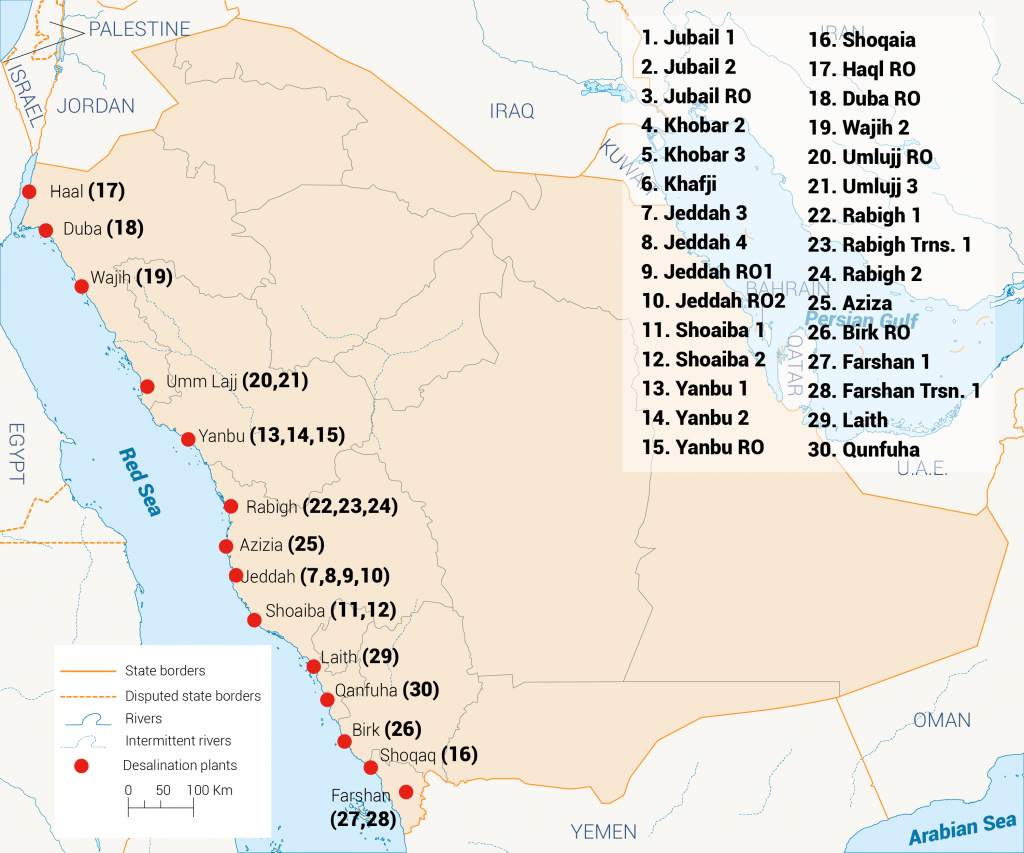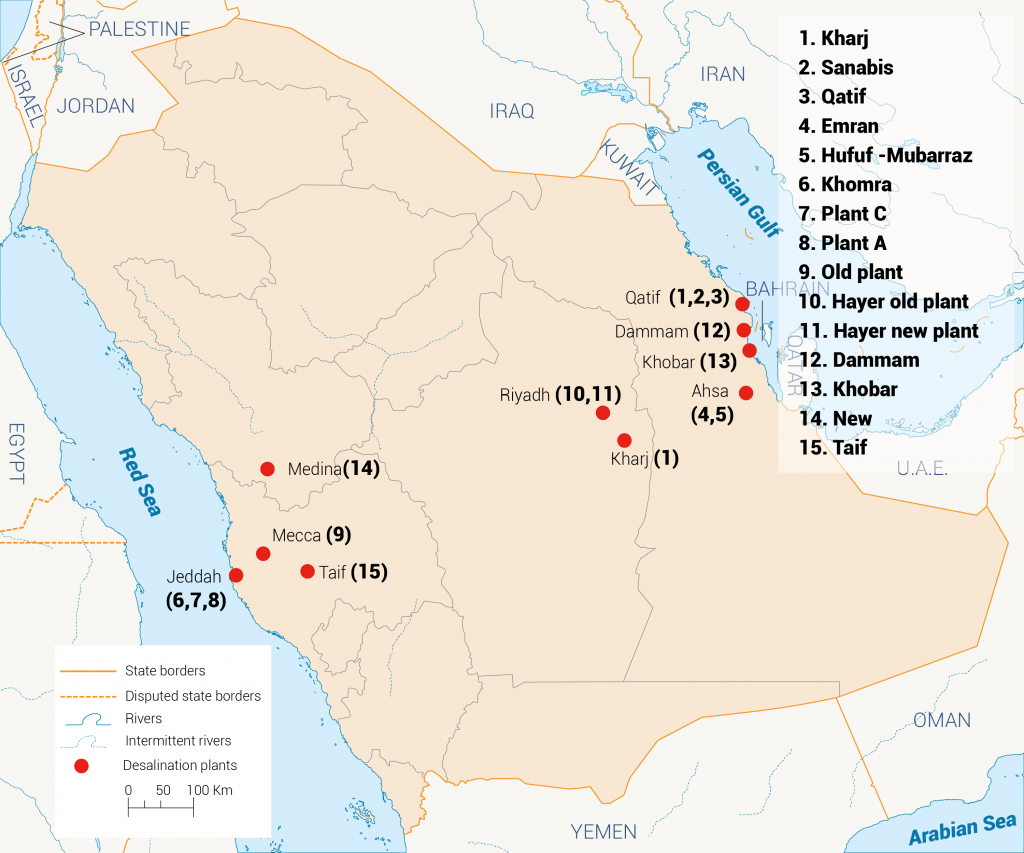
In order to overcome the water scarcity and the increasing demand, investments have been undertaken in the water infrastructure in KSA.
Water and sanitary networks
KSA’s main water pipelines extend more than 8,000 km, the majority of which are owned and operated by the Saline Water Conversion Corporation (SWCC).[1] The total length of the water network in 2019 was 121,356 km, and the number of domestic water connections was 2.26 million. At the same time, the length of the wastewater collection network was 43,729 km, and the number of domestic connections was 1.46 million.[2]
Dams
There are 522 dams around the country (Map 1), with a total capacity of 2.30 BCM to facilitate storage and surface runoff and groundwater recharge. The total amount of the utilized water from dams is about 1.6 BCM/yr. Some 73% of the total utilized water from dams is in the regions of Asir, Mecca and Jazan. These areas contain abundant renewable groundwater and surface water due to their rocky, non-porous terrain at the level of the Arab Shield.[3]
Table 1 shows the regional distribution, capacities and purposes of the dams, while the details of the major dams are shown in Table 2.
Table 1: Regional distribution, capacities and purposes of the dams in KSA.[4]
| Region | Number of dams | Capacity (MCM) | Purpose |
| Riyadh | 107 | 106.96 | Groundwater recharge and flood control |
| Mecca | 60 | 883.32 | Drinking water and flood control |
| Medina | 41 | 111.91 | Drinking water, groundwater recharge and flood control |
| Qassim | 18 | 8.86 | Groundwater recharge and flood control |
| Eastern | 2 | 11.22 | Groundwater recharge and flood control |
| Asir | 118 | 521.13 | Drinking water, groundwater recharge and flood control |
| Tabuk | 19 | 17.87 | Groundwater recharge and flood control |
| Hail | 46 | 27.80 | Groundwater recharge and flood control |
| Northern Border | 11 | 61.71 | Groundwater recharge and flood control |
| Jazan | 15 | 331.19 | Irrigation, drinking water, groundwater recharge and flood control |
| Najran | 26 | 103.74 | Drinking water, groundwater recharge and flood control |
| Baha | 49 | 104.06 | Drinking water, groundwater recharge and flood control |
| Jawf | 10 | 14.61 | Drinking water, groundwater recharge and flood control |
| Total | 522 | 2,304.39 |
Water treatment plants
There are 353 water treatment plants built on dams and groundwater wells, with an overall production capacity of 2.07 MCM/d. Table 3 provides an overview.
Table 3: Regional distribution and capacities of water treatment plants on dams and wells in KSA.[8]
| Region | Number of plants | Total designed capacity (m3/d) | Total production capacity (m3/d) |
| Riyadh | 87 | 1,468,250 | 1,060,333 |
| Mecca | 7 | 241,750 | 118,238 |
| Medina | 33 | 25,800 | 5,958 |
| Qassim | 27 | 541,400 | 415,269 |
| Eastern | 61 | 129,000 | 21,548 |
| Asir | 16 | 211,700 | 66,693 |
| Tabuk | 16 | 4,900 | 3,070 |
| Hail | 34 | 171,600 | 156,730 |
| Northern Border | 31 | 55,600 | 42,381 |
| Jazan | 9 | 153,600 | 109,089 |
| Najran | 20 | 24,400 | 11,279 |
| Baha | 4 | 78,000 | 25,165 |
| Jawf | 8 | 31,800 | 31,817 |
| Total | 353 | 3,137,800 | 2,067,570 |
Desalination plants
Between 1980 and 2011, 30 desalination plants were built along the coasts of the Red Sea and Persian Gulf, producing the largest quantity of desalinated water of any country. By 2020, there were 33 desalination plants in KSA.[9] The locations of these desalination plants are shown in Map 2.[10] The main techniques used are multi-effect desalination (MED), multi-stage flash (MSF) and reverse osmosis (RO). Daily production in 2017 was around 4 MCM using different desalination technologies. Of the total desalinated water currently produced, 77.5% is produced by MSF, 20.5% by RO and 2% by MED plants.
KSA produced 7.65 MCM of desalinated water in 1980.[11] This amount increased to approximately 1,070 MCM in 2004 and 1,048 MCM in 2009. The plant-specific production of desalinated water, desalination approaches, commission dates and years of service are presented in Table 4.[12]
The SWCC is considered to be the largest producer of desalinated water and owns the majority of desalination plants in KSA, accounting for 73% of the total production capacity.[13] To meet the potable water demand, which is expected to be 8.5 MCM/d by 2025, SWCC is aiming to increase its installed water production capacity to around 8.8 MCM/d by 2030.
Desalinated water is mainly used for domestic purposes in the major cities. Of these cities, Riyadh, Mecca, Medina and Dammam consume approximately 90% of the desalinated water. [14]
Table 4: Summary of the major desalination plants in KSA.[15]
| Plant | Supply (MCM/yr) | Plant total (MCM/yr) | Date of commission | Stage |
| Jubail 1 | 43.23 | 369.31 | 1982 | 1st |
| Jubail 2 | 297.54 | 1983 | 2nd | |
| Jubail RO | 28.54 | 2000 | RO | |
| Khobar 2 | 70 | 157.89 | 1983 | 2nd |
| Khobar 3 | 87.89 | 2000 | 3rd | |
| Jeddah 3 | 27.74 | 132.95 | 1979 | 3rd |
| Jeddah 4 | 69.55 | 1982 | 4th | |
| Jeddah RO 1 | 17.83 | 1989 | 1st | |
| Shoaiba 1 | 70 | 212.68 | 1989 | 2nd |
| Shoaiba 2 | 142.68 | 2001 | 1st | |
| Yanbu 1 | 34.54 | 117.4 | 1981 | 2nd |
| Yanbu 2 | 43.84 | 1998 | RO | |
| Yanbu RO | 39.02 | 1998 | 1st | |
| Shoqaia | 30.45 | 30.45 | 1989 | 1st |
| Wajih | 3.29 | 3.29 | 2009 | 3rd, MED |
| Umluj RO | 1.38 | 1.38 | 1986 | RO |
| Rabigh 2 | 6.57 | 6.57 | 2009 | 2nd, MED |
| Aziziyah | 1.41 | 1.41 | 1987 | 1st |
| Farasan 1 | 0.16 | 0.16 | 1979 | 1st |
Wastewater treatment plants
There are 99 wastewater treatment plants (WWTPs) in KSA. The location of the major WWTPs is presented in Map 3. Riyadh, Mecca and the Eastern Province account for about 79% of the country’s total capacity. Table 5 describes the main features of the major WWTPs.
Table 5: Major WWTPs in KSA.
| WWTP | Technology | Capacity (m3/d) | Treatment level | Purpose |
| Manfouha-Riyadh | Trickling filter, activated sludge | North 200,000, South 200,000, East 200,000 | Tertiary | Irrigation |
| Heet-Alkharj | Activated sludge | Phase I 100,000, Phase II 100,000, Phase III (under construction) 200,000 | Tertiary | Irrigation, groundwater recharge |
| Hayer-Riyadh | Activated sludge | Phase I 400,000 | Tertiary | Irrigation, groundwater recharge |
| Refinery-Riyadh | Clarification and filtration | 20,000 | Tertiary | Agricultural irrigation |
| Dammam | Activated sludge | 215,000 | Tertiary | Landscape irrigation |
| Medina | Media filtration | 460,000 | Tertiary | Agricultural irrigation |
| Taif | Activated sludge | 190,000 | Tertiary/secondary | Landscape irrigation |
| Mecca | Trickling filter/activated sludge | Phase I 24,000, Phase II 50,000 | Tertiary | Irrigation and industrial |
| Qatif | Oxidation ditch | 210,000 | Tertiary | Landscape |
| Khobar | Oxidation ditch | 133,000 | Tertiary | Landscape |
[1] Ministry of Environment, Water and Agriculture, 2019. Statistical book: Year 2019 (1440-1441).
[2] Ibid.
[3] Ministry of Environment, Water and Agriculture, 2018. National Water Strategy 2030.
[4] Ministry of Environment, Water and Agriculture, 2019. Statistical book: Year 2019 (1440-1441).
[5] Abu-Abdullah, MM et al., 2020. A flood risk management program of Wadi Baysh dam on the downstream area: An integration of hydrologic and hydraulic models, Jizan region, KSA. Sustainability 12(3): 1069.
[6] Fosroc, nd. Hali Dam, Saudi Arabia.
[7] Chowdhury S and Al-Zahrani M, 2015. Characterizing water resources and trends of sector wise water consumptions in Saudi Arabia. Journal of King Saud University – Engineering Sciences 27(1); 68-82.
[8] Ministry of Environment, Water and Agriculture, 2019. Statistical book: Year 2019 (1440-1441).
[9] US-Saudi Business Council, 2021. Water in Saudi Arabia: Desalination, wastewater and privatization.
[10] Chowdhury S and Al-Zahrani M, 2015. Characterizing water resources and trends of sector wise water consumptions in Saudi Arabia. Journal of King Saud University – Engineering Sciences 27(1); 68-82.
[11] SWCC, 2011. General organization of water desalination.
[12] Ibid.
[13] Ministry of Environment, Water and Agriculture, 2018. National Water Strategy 2030.
[14] Chowdhury S and Al-Zahrani M, 2015. Characterizing water resources and trends of sector wise water consumptions in Saudi Arabia. Journal of King Saud University – Engineering Sciences 27(1); 68-82.
[15] SWCC, 2011. General organization of water desalination.



